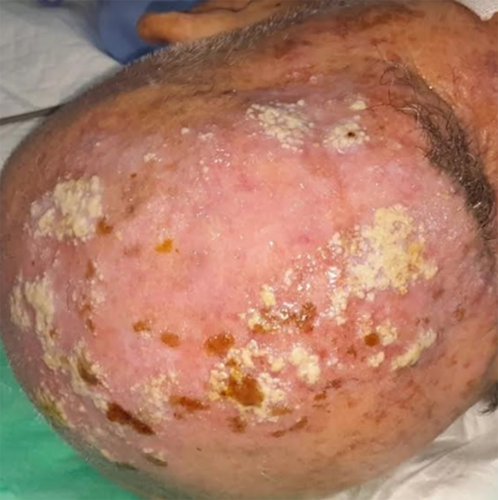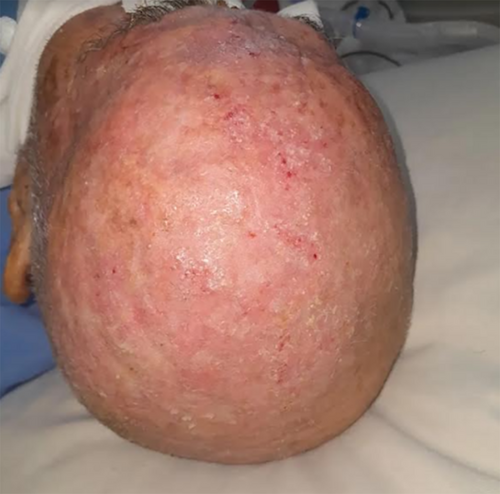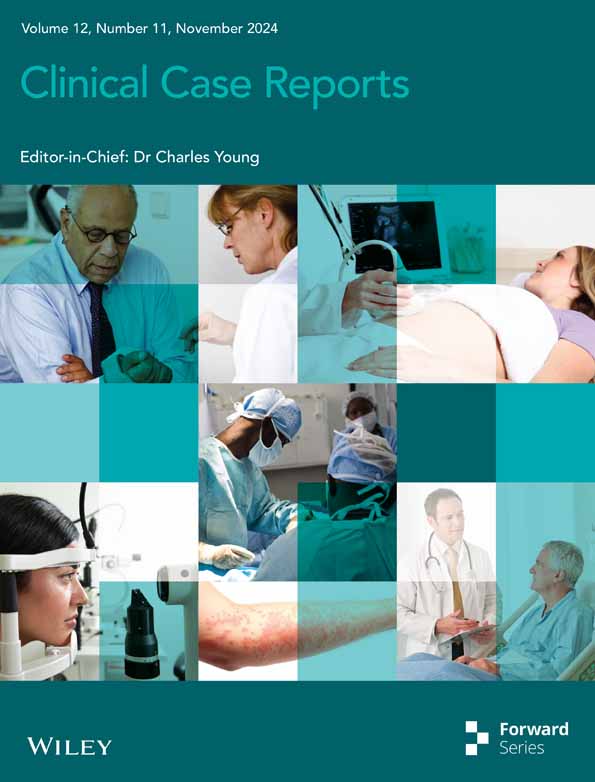The Role of Moist Dressings in the Management of Herpes Zoster With Scalp Involvement: A Case Report
Funding: The authors received no specific funding for this work.
ABSTRACT
Comprehensive management, including antivirals and pain control, is crucial for mitigating complications and improving patient outcomes in herpes zoster. Moist wound dressings, specifically hydrocoll, effectively reduce pain, and promote healing in herpes zoster with scalp involvement, as demonstrated in the case of a 76-year-old male.
1 Introduction
Varicella zoster virus (VZV) is classified as a double-stranded DNA alphaherpesvirus responsible for the development of both varicella (chickenpox) and herpes zoster (HZ; shingles) [1]. HZ is caused by the reactivation of latent VZV in a sensory nerve ganglion, often appearing decades after the initial infection [2, 3].
The HZ typically affects older adults and individuals with weakened immune systems, and it is characterized by a painful, itchy rash that follows a single or multiple adjacent dermatomal distributions [4]. In addition, studies have shown that HZ can be caused by the side effects of some drugs such as upadacitinib [5]. Roughly one out of every three people will encounter HZ at least one time in their life, which accounts for a significant health issue on a global scale [1].
The shingles can lead to various complications, including postherpetic neuralgia (PHN), the most common and debilitating condition marked by persistent pain following the resolution of the rash [6, 7]. Other complications can include ocular disorders such as HZ ophthalmicus [8], neurological issues such as meningoencephalitis, cranial, and peripheral nerve palsies [9, 10], and in rare cases, disseminated disease, particularly in immunocompromised individuals [11, 12].
The pain associated with PHN can be severe and debilitating, and traditional treatments such as analgesics, anticonvulsants, and antidepressants may not always provide adequate relief. Timely medical intervention and appropriate management of shingles are crucial in minimizing the risk of these complications and promoting recovery [13, 14].
HZ (shingles) typically presents with a painful, vesicular rash in a dermatomal distribution, but scalp involvement is relatively rare, representing a smaller proportion of cases [15]. While cutaneous manifestations are common on the trunk and thorax, shingles affecting the scalp, especially with ophthalmic complications, are less frequently reported in the literature, highlighting the uniqueness of such cases. Additionally, the use of hydrocolloid dressings like hydrocoll for symptom management in shingles is not widely documented. These moist dressings are more commonly associated with the treatment of ulcers and other skin injuries due to their ability to provide a moist environment and promote healing [16]. However, in the context of scalp shingles, their application appears to be novel, suggesting an innovative approach to managing this condition.
2 Case History/Examination
This scenario describes a new onset case of HZ ophthalmicus in a 76-year-old Persian male patient from Iran, with no prior interventions or special measures taken for this condition. Upon hospital admission, he exhibited severe ocular discomfort, including pain, burning, itching, and a stinging sensation in the left eye, alongside systemic symptoms resembling influenza, such as generalized pain and fatigue. His medical history was notable for chronic hypertension and congestive heart failure, and atrial fibrillation was detected during an electrocardiogram (ECG) evaluation. The patient's responsiveness was assessed using the FOUR (Full Outline of UnResponsiveness) Score scale, which yielded a score of 8 out of 16, indicating moderate impairment but that he was conscious, alert, and able to consume fluids. Additionally, the patient exhibited a case of shingles affecting the scalp, encompassing more than half of the scalp, as depicted in Figure 1.

3 Diagnosis/Treatment
3.1 Basic Laboratory Results
The serological assessment revealed an elevated C-reactive protein (CRP) of 56 mg/L, an erythrocyte sedimentation rate (ESR) of 29 mm/h, a neutrophil count of 69%, lymphocyte count of 29%, white blood cell (WBC) count of 9.7 × 109/L, and thrombocytopenia with a platelet (PLT) count of 89 × 109/L. Urinalysis showed the presence of protein (+) and blood (+++). Arterial blood gas (ABG) analysis reported a PaCO2 of 26 mmHg, pH of 7.52, and bicarbonate (HCO3−) of 20.8 mmol/L, which was consistent with a diagnosis of fully compensated respiratory alkalosis.
3.2 Treatment
The multidisciplinary approach to management included consultations with an ophthalmologist, a cardiologist, and a wound care specialist. The ophthalmologist recommended the use of topical steroid ointments and antiviral agents, following the treatment protocols advocated by Cohen and Jang [17], to manage ocular involvement. The patient was administered aciclovir (10 mg/kg IV every 8 h) for 14 days to address the viral infection, and pain management was achieved with fentanyl and paracetamol (Apotel) formulation. However, corticosteroid therapy, essential for inflammation control, led to hyperglycemia, a known side effect requiring careful blood sugar monitoring. Therefore, the use of corticosteroid was hold. A notable and rare aspect of this case was the occurrence of scalp shingles, which the patient presented with upon admission. The management of this localized herpetic manifestation involved the application of hydrocoll wet dressings. hydrocolloid dressing (Comfeel Plus) was used once every day.
4 Results
The patient's condition improved with the comprehensive treatment plan, including meticulous monitoring of his vital signs and symptoms. In addition, serological parameters of the patient showed significant improvements (Table 1).
| Test parameters | First day results (unit) | 14th day results (unit) | Changes | Normal range |
|---|---|---|---|---|
| Biochemistry | ||||
| FBS | 184 | 168 | −16 | 82–115 (mg/dL) |
| Urea | 25 | 91 | + 66 | 17–49 (mg/dL) |
| Crea | 1.1 | 1.0 | −0.1 | 0.8–1.3 (mg/dL) |
| Na | 130 | 159 | + 29 | 135–148 (mEq/L) |
| K | 4.4 | 4.1 | −0.3 | 3.5–5.5 (mEq/L) |
| Serology | ||||
| PT | 14 | 11.8 | −2.2 | 11–13.5 (s) |
| PTT | 32 | 30 | −2 | 25–36 (s) |
| INR | 1.2 | 1 | −0.2 | 0.8–1.1 (INR) |
| CRP | 56 | 1 | −55 | Up to 6 (mg/L) |
| Hematology | ||||
| WBC | 9.7 | 12.9 | + 3.2 | 4.5–11 (1012/L) |
| RBC | 5.69 | 4.46 | −1.23 | 4.6–5.9 (1012/L) |
| Hb | 16.6 | 12.5 | −4.1 | 14–18 (g/dL) |
| HCT | 48.2 | 39.7 | −8.5 | 42%–52% |
| MCV | 84.71 | 89.01 | + 4.3 | 80–96 (FL) |
| MCH | 29.17 | 28.03 | −1.14 | 27–32 (pg) |
| MCHC | 34.44 | 31.49 | −2.95 | 32%–36% |
| Plt | 89 | 167 | + 78 | 140–450 (109/L) |
| ESR 1 h | 29 | 27 | −2 | 2–18 (mm/h) |
| Neutrophils | 69 | 88 | 19 | 40%–60% |
| Lymphocytes | 29 | 7 | −22 | 20%–40% |
Notably, the use of hydrocoll dressing on scalp shingles led to a significant improvement and reduction of pain from 8 to 3 on the visual analogue scale (VAS) within 2 days (Figure 2). Additionally, rigorous preventative measures against pressure ulcers were taken due to his bedridden status and nutritional challenges, involving regular repositioning and careful attention to potential pressure points.

5 Discussion
This study's findings align with the current understanding of HZ (shingles) management, which includes the use of antiviral agents, pain control, and, in certain circumstances, corticosteroids. The serological markers observed in the patient, such as elevated CRP and ESR, suggest an acute inflammatory response, which is consistent with the active phase of shingles [18].
Treatment for HZ includes antiviral medications such as acyclovir, valacyclovir, and famciclovir, which are used for mild to moderate infections. In severe cases, intravenous acyclovir is the drug of choice. Foscarnet is used when acyclovir resistance is suspected or confirmed [19, 20]. Acyclovir-resistant strains of VZV have been reported, but the incidence is low [21]. Therefore, in this case, acyclovir was used, its effectiveness in reducing the severity and duration of HZ as documented in several studies [17, 20, 22].
A study by Acar et al. evaluated the clinical features of HZ patients hospitalized in a dermatology clinic of a tertiary hospital. The study found that disseminated HZ was seen in 36.8% of patients, and ophthalmic HZ was present in 63.2% of cases. The relationship between dissemination, age, gender, presence of immunosuppression, and development of postherpetic neuralgia was not statistically significant [23]. In this case, the patient had eye involvement, which was used the approach mentioned by Cohen and Jang, which includes steroid and antiviral ointments. These treatments aim to reduce inflammation and viral load, thereby potentially preserving vision and preventing long-term complications such as keratitis [17].
In addition to antiviral treatment, pain management is essential for patients with HZ. This may include over-the-counter pain relievers, prescription medications, and other therapies such as nerve blocks or physical therapy [24]. The prescription of fentanyl and Apotel (paracetamol) for pain and restlessness is in line with the multimodal approach to pain management in shingles, which often requires both systemic and local interventions [25]. However, the use of corticosteroids, such as methylprednisolone and hydrocortisone, remains controversial. Some studies suggest that corticosteroids may reduce the incidence of PHN [26, 27]. However, other studies caution against the use of corticosteroids, especially in immunocompromised patients. A study by Qian et al. showed that patients who take systemic corticosteroids are more likely to get HZ [28]. So, the use of corticosteroids has many side effects that must be considered [29].
Hydrocolloid dressings are primarily used for their ability to maintain a moist wound environment, which is beneficial for wound healing [30]. The mechanism of action of hydrocolloid dressings in the management of HZ lesions is centered around their capability to create an optimal moist environment that facilitates the body's natural healing processes. This environment promotes autolytic debridement, which helps remove necrotic tissue and reduces the risk of infection [31]. Additionally, the moist environment provided by hydrocolloid dressings can aid in reducing pain and discomfort by protecting nerve endings and minimizing exposure to air, which can be irritating in open wounds [32]. A Study by Bolton et al. demonstrated that due to their nature as wounds, it is imperative to promptly treat HZ vesicles with dressings that retain moisture to reduce the likelihood of infection, discomfort, itching, prolonged healing duration, and damage caused by abrasions and tears [33]. A study demonstrated that the use of hydrocolloid dressings resulted in significant pain reduction and accelerated healing time, as evidenced by a decrease in the Visual Analogue Scale from 9/10 to 4/10 [34]. Comparatively, foam dressings and other alternatives are also used in shingles management, providing similar benefits of moisture retention and protection against external contaminants [33]. However, the specific properties of hydrocolloid dressings, such as their viral barrier capabilities and ability to modulate wound surface pH, may offer distinct advantages in certain clinical scenarios, potentially leading to superior outcomes in terms of pain relief, and healing speed. The search on PubMed did not yield other clinical therapeutic studies evaluating the use of hydrocolloid moist dressings for pain relief and expedited healing in these conditions. In this regard, what can be seen from the results, the use of wet hydrocoll dressing can be useful in patients with HZ.
5.1 Limitations
This case report's findings are limited by its nature as a single-case study, which inherently restricts the generalizability of the results. The improvements observed with the use of hydrocoll moist dressings in managing scalp shingles may not universally apply to all patients due to variations in individual conditions, underlying health issues, and responses to treatment. Additionally, the conclusions drawn from one patient's response to treatment lack the statistical power that could be provided by larger, controlled trials. Therefore, while the results are promising, they should be interpreted with caution, and further research involving a larger cohort is necessary to substantiate these findings and potentially recommend broader clinical applications.
6 Conclusions
This case report highlights the potential benefits of using hydrocoll moist dressings in managing scalp shingles, as evidenced by significant pain reduction and favorable changes in inflammatory markers. While commonly utilized treatments include antivirals and steroids, adding moist dressings presents a promising adjunct therapy. The findings suggest that hydrocoll dressings can offer a soothing effect and faster healing of lesions, which could be particularly beneficial for patients experiencing severe symptoms. Future research should aim to validate these preliminary observations through controlled studies to potentially incorporate this treatment into broader clinical guidelines for HZ management.
Author Contributions
Mohammad Reza Faramarzi: conceptualization, data curation, formal analysis, funding acquisition, investigation, methodology, project administration, supervision, writing – review and editing. Erfan Hosseinian: conceptualization, investigation, writing – original draft, writing – review and editing. Esmaiel Maghsoodi: conceptualization, data curation, methodology, project administration, supervision, validation, writing – original draft, writing – review and editing.
Acknowledgments
We thank the patient for granting permission to share his medical case and the medical staff for their dedicated care and support. Special thanks to the multidisciplinary team for their insights and collaboration in managing this case.
Ethics Statement
The study was conducted according to the relevant guidelines of the Declaration of Helsinki and regulations in ethics approval, accordance, and consent to participate. Ethics approval was obtained from the Maragheh University of Medical Sciences.
Consent
The study was conducted according to the relevant guidelines of the Declaration of Helsinki and regulations in ethics approval, accordance, and consent to participate. A written informed consent was obtained from the patient. Patient anonymity was guaranteed. Ethics approval was obtained from the Maragheh University of Medical Sciences. Written informed consent for publication of this case report and any accompanying images was obtained from the patient.
Conflicts of Interest
The authors declare no conflicts of interest.
Open Research
Data Availability Statement
The datasets used and/or analyzed during the current case study are available from the corresponding author upon reasonable request.




